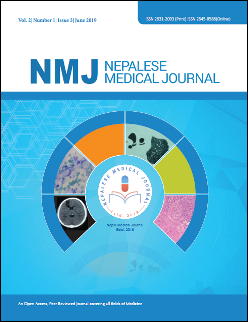Systemic Lupus Erythematosus and Pregnancy Outcome in Tertiary Level Hospital of Nepal
DOI:
https://doi.org/10.3126/nmj.v2i1.24496Keywords:
Abortion, Anti-phospholipid antibody, Glomerulonephritis, Pre-eclampsia, Pregnancy, Systemic Lupus ErythematosusAbstract
Introduction: Systemic Lupus Erythematosus is an autoimmune disease frequently prevalent in women starting from early childhood and towards the reproductive age. Pregnancy with SLE has always imposed great risk both to the mother and the fetus. A multidisciplinary approach with Nephrologist, neonatologist and senior obstetrician during remission leads to a favorable response, through limitation and complications with the use of drugs impose difficulties in their management.
Materials and Methods: A prospective, descriptive study was conducted in the Department of Obstetrics and Gynecology and Nephrology at Tribhuvan University Teaching Hospital, for 2 years, from June 2015 to 2017. The study included obstetrical and related complications with outcome in pregnant patients with Systemic Lupus Erythematosus.
Results: A total of 19 cases were analyzed of which 15 (79%) had a viable pregnancy and 4 (21%) abortions. Of thirteen cases, 4 (21%) had antiphospholipid antibody syndrome, 8 (42.1%) lupus, and membranous glomerulonephritis and 1 (5.2%) lupus optic neuropathy with loss of vision. All the patients were under drug therapy, like prednisolone, azathioprine, hydroxychloroquine, aspirin, low molecular weight Heparin, tacrolimus, and cyclophosphamide. Only 2 (10.5%) of 19 developed severe pre-eclampsia. There were 12 (80%) term and 3 (20%) each of preterm and intrauterine growth retardation pregnancies with 1 (6.6%) neonatal death (NND) and 1 (5.2%) maternal mortality.
Conclusions: Multidisciplinary approach and planned pregnancy reduces the risk of probable complications in the patient resulting to a decreased morbidity and mortality.
Downloads
Downloads
Published
How to Cite
Issue
Section
License
This license enables reusers to distribute, remix, adapt, and build upon the material in any medium or format, so long as attribution is given to the creator. The license allows for commercial use.
Copyright on any article published by Nepalese Medical Journal is retained by the author(s).
Authors grant Nepalese Medical Journal a license to publish the article and identify itself as the original publisher.
Authors also grant any third party the right to use the article freely as long as its integrity is maintained and its original authors, citation details and publisher are identified.




